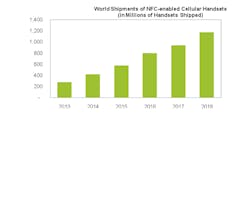IHS Technology, an information source for consumer electronics, predicts that global shipments of Near Field Communication (NFC) equipped technology will more than quadruple from 2013 to 2018, reaching 1.2 billion units. NFC is a short-range, high-frequency wireless communication technology. It allows cellphones to communicate with other NFC-enabled devices, as well as smartcards and readers. In 2013, shipments of NFC-enabled cellphones rose from 120 million (in 2012) to 275 million units. That 128 percent increase is expected to grow by another 50 percent in 2014, reaching 416 million units worldwide. The increase from 2013 to 2018 is predicted to be a momentous 325 percent.
Although this data suggests a vast impact on cellphone shipments, just 18.2 percent of the 1.5 billion cellphones shipped worldwide in 2013 were NFC outfitted. However, by 2018 that number will soar to 65 percent. Currently, a major challenge for the NFC market is developing services and applications that consumers want. The slow pace at which mobile payments are being embraced is another challenge slowing down growth. NFC, initially targeted at cellphones, has now expanded to include a range of devices—such as tablets, sports and medical devices, and gaming consoles.
Android-based smartphones are presently dominating the NFC market, holding 93 percent (254 million units) of all NFC-enabled cellphone shipments. By 2018, Android is expected to represent 7 5 percent of NFC cellphone shipments with 844 million units. 90 percent, or 267 million units, of current NFC-enabled cellphones are embedded with a standalone modem device directly in the handset. Other methods, such as combination connectivity integrated circuits (ICs), are expected to become more popular by 2018.
About the Author
Sarah Mangiola
Sarah Mangiola has written on many different topics within Penton's Design, Engineering, and Sourcing Group. Originally from California, she graduated from the University of California, Davis with a B.A. in political science.
